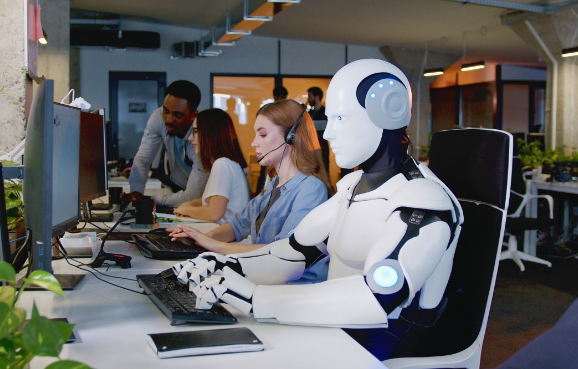Introduction
The workplace as we know it is undergoing a profound transformation, driven by the relentless advancement of technology. From automation and artificial intelligence to remote work solutions, technology is revolutionizing how we work, where we work, and the tools we use to perform our jobs. In this article, we’ll explore the ways in which technology is reshaping the modern workplace and what this means for the future of work.
1. Remote Work and Virtual Collaboration
Perhaps the most visible change in the workplace is the rise of remote work. Technology, especially high-speed internet and collaborative tools, has made it possible for employees to work from anywhere. This shift not only provides flexibility to workers but also allows businesses to tap into a global talent pool.
- Collaboration Tools: Platforms like Microsoft Teams, Slack, and Zoom have become indispensable for virtual team meetings, file sharing, and real-time communication.
- Cloud Computing: Cloud-based solutions like Google Workspace and Microsoft 365 enable employees to access and collaborate on documents from any location.
- Project Management Software: Tools like Asana and Trello facilitate project coordination and tracking across distributed teams.
2. Automation and Artificial Intelligence (AI)
Automation and AI are streamlining processes and increasing efficiency across various industries. This technology is handling repetitive and time-consuming tasks, allowing employees to focus on higher-value work.
- Robotic Process Automation (RPA): RPA software automates rule-based tasks, such as data entry and data extraction, in industries like finance, healthcare, and manufacturing.
- AI Chatbots: Chatbots provide customer support, answer queries, and facilitate user interactions, reducing the need for human intervention.
- Machine Learning: Machine learning algorithms are used for data analysis, customer insights, and predictive maintenance in sectors like e-commerce and healthcare.
3. Augmented Reality (AR) and Virtual Reality (VR)
AR and VR technologies are making inroads into the workplace, particularly in training and design-related fields. They enable immersive experiences that enhance learning and collaboration.
- Training and Simulation: VR is used for employee training, allowing workers to practice tasks in a safe, virtual environment.
- Design and Prototyping: In industries like architecture and product design, AR and VR enable 3D modeling and immersive design reviews.
4. The Gig Economy and Freelancing Platforms
Technology platforms have created opportunities for individuals to work as freelancers or in the gig economy. This has led to greater flexibility for workers and new business models for companies.
- Freelancing Platforms: Websites like Upwork and Freelancer connect businesses with freelancers in various fields, from graphic design to content writing.
- Ride-Sharing and Food Delivery: Apps like Uber and DoorDash provide income opportunities for drivers and delivery partners.
5. Data Analytics and Business Intelligence
The workplace is becoming increasingly data-driven, with technology playing a central role in collecting, analyzing, and visualizing data.
- Data Analytics Tools: Platforms like Tableau and Power BI help businesses make data-driven decisions by creating interactive visualizations and reports.
- Predictive Analytics: AI-powered predictive analytics tools offer insights into customer behavior, inventory management, and workforce planning.
6. Wearable Technology and Wellness Programs
Wearable devices, such as smartwatches and fitness trackers, are promoting employee wellness and safety in the workplace.
- Health and Wellness Tracking: Wearables monitor physical activity, heart rate, and sleep patterns, promoting healthier lifestyles and reducing healthcare costs.
- Safety in High-Risk Industries: In high-risk jobs, wearables can track vital signs and environmental data to ensure worker safety.
7. Cybersecurity and Data Protection
As technology advances, so do cybersecurity threats. Protecting sensitive data is a top priority for businesses.
- Endpoint Security: Companies use endpoint security solutions to protect devices and data, especially in remote work scenarios.
- Training and Awareness: Employee training on cybersecurity best practices is crucial to prevent data breaches and cyberattacks.
8. Flexible Work Arrangements
Technology is enabling flexible work arrangements beyond remote work, such as flextime and compressed workweeks. These arrangements promote work-life balance and employee well-being.
9. The Role of Artificial Intelligence in HR
AI is transforming human resources by automating administrative tasks and improving the hiring process.
- Recruitment: AI tools screen resumes, conduct initial interviews, and predict candidate success.
- Employee Engagement: AI-driven surveys and analytics assess and improve employee engagement and job satisfaction.
10. Blockchain Technology
Blockchain is revolutionizing industries such as finance and supply chain. It ensures transparent and secure transactions and data sharing.
- Supply Chain Management: Blockchain verifies the authenticity and origin of products in supply chains, reducing fraud and ensuring quality.
- Digital Currencies: Cryptocurrencies are changing the way transactions are conducted, offering an alternative to traditional financial systems.
11. Environmental Impact and Sustainability
Technology is being harnessed to reduce the environmental footprint of businesses. Innovations include energy-efficient technologies, sustainable materials, and waste reduction practices.
12. Enhanced Employee Benefits
Technology is allowing companies to offer improved benefits to attract and retain top talent. These include flexible work options, wellness programs, and digital learning opportunities.
Conclusion: Adapting to the Digital Era
The workplace of the future is being shaped by technology in profound ways. From remote work and automation to data analytics and AI, these advancements are transforming how we work and the tools we use to achieve our goals. While technology offers numerous advantages, it also presents challenges, from cybersecurity concerns to ethical considerations. Staying adaptable, investing in training and education, and maintaining a keen awareness of technology’s evolving role will be essential as we navigate the ever-changing landscape of work in the digital era.




